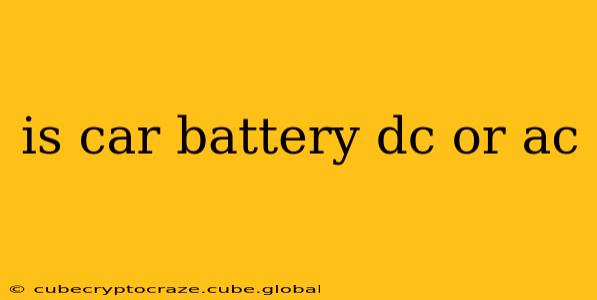Car batteries are a crucial component of any vehicle, providing the power needed to start the engine and run various electrical systems. But what kind of power do they deliver? The simple answer is Direct Current (DC). This article will delve deeper into the reasons why car batteries use DC, exploring common misconceptions and answering frequently asked questions.
Why Car Batteries Use Direct Current (DC)
Car batteries use DC because most of the vehicle's electrical components are designed to operate on direct current. This includes everything from the headlights and taillights to the radio and the engine's computer system. These components are built with circuitry that expects a consistent flow of electrons in one direction – the hallmark of DC power. In contrast, alternating current (AC) periodically reverses the direction of electron flow, which would damage or malfunction most car parts.
What is the Difference Between AC and DC?
To fully understand why car batteries use DC, let's briefly differentiate between AC and DC electricity:
- Direct Current (DC): Electrons flow consistently in one direction. This is the type of electricity produced by batteries and is used in most electronic devices that require a power source (e.g. your smartphone, laptop).
- Alternating Current (AC): Electrons flow in one direction, then reverse, changing direction periodically. This is the type of electricity that is typically supplied by power grids to homes and businesses.
How Does a Car Battery Produce DC?
The electrochemical reactions within a car battery generate DC electricity. The battery's internal structure, involving lead plates and an electrolyte solution, facilitates a chemical process that produces a consistent flow of electrons in one direction. This process maintains a constant voltage, typically around 12 volts for most car batteries.
Can I Use AC Power in My Car?
No, directly connecting AC power to your car's electrical system is extremely dangerous and will likely damage or destroy its components. The car's electrical system is not designed to handle the fluctuating voltage and current of AC power. Your car's alternator, however, does generate AC power, which is then converted to DC using a rectifier before being sent to the battery and vehicle's electrical systems.
Why Doesn't My Car Use AC Power?
Using AC power directly in a car presents several major challenges:
- Component Compatibility: As mentioned earlier, almost all of a car's electrical components are designed for DC. Using AC power would lead to immediate and significant malfunctions.
- Safety Concerns: The high voltage fluctuations in AC power pose a serious safety hazard, increasing the risk of electrical shocks and fires.
- Complexity and Cost: Adapting a car's electrical system to utilize AC power would require a major redesign, increasing complexity and cost significantly.
What About the Alternator? Doesn't it Produce AC?
This is a common point of confusion. The alternator in your car does initially produce AC power. However, this AC power is immediately converted to DC through a rectifier before it reaches the battery or other vehicle systems. This conversion is crucial for the proper functioning of the car's electrical system.
In conclusion, car batteries are definitively DC power sources, specifically designed to provide the consistent, unidirectional electrical flow required by the car's numerous DC-powered components. The use of DC is fundamental to both the safety and functionality of your vehicle.
